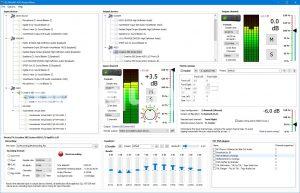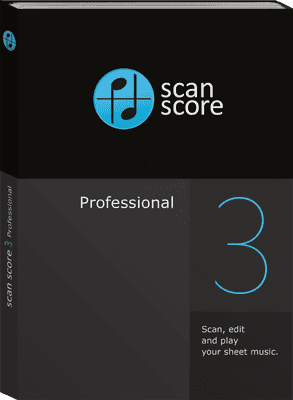
File size: 43.2 MB
DS WASAPI ASIO路由器混音器是音频输入到音频输出路由器/混音器,支持直接声音,WASAPI和ASIO模式。通过矩阵混合,VST DSP插件支持,11频段均衡器和录音选项,可以将任何类型和数量的音频输入路由到任何类型的音频输出。 ASIO输出混频器可选地为多线程的,以实现具有DSP的高分辨率96 / 192KHz输出的最低延迟。均衡器,矩阵混合和VST DSP具有预设的系统来存储和调用设置。
使用DS WASAPI ASIO路由器混合器的基本步骤:
在窗口的中上部,选择一个输出设备。在右侧设置所需的格式,然后单击“启用”开关。如果需要,ASIO通道对将继承根设备的参数,首先是根参数集。
在窗口的左侧,选择一个输入设备。在右侧(整个窗口的中心),选择输入的所需格式,然后单击“启用”开关。所选的输入设备将开始在先前选择的输出设备上播放。始终通过最后选择的输出设备启用输入设备。可以为一个输出设备启用多个输入设备,但是一个输入设备仅支持1个输出,但是在输入设备选项面板中(底部)可以指定另一个“监视器”输出设备,之前启用,也将播放所选的输入设备。
要访问底部的3个FX,请从列表中选择一个输入或输出设备。最后选择的输入或输出设备将受到影响。下部面板的groupbox标题显示当前所选设备的名称(来自输出的输入)。
例如,要将均衡器应用到设备,请设置EQ轨迹条,然后单击“启用”。当然,这些参数也可以随时更改。
ASIO通道对从根设备接收音频数据,并且在根设备上设置任何效果(例如音量或EQ,VST DSP)都会影响所有通道对。请注意,大多数VST DSP插件仅支持立体声,因此其他1/2声道可能不会受到影响或静音,在这种情况下,请在声道对上设置VST DSP。
提示:
输入和输出通道/设备的“格式”设置可能无效。 WASAPI和根ASIO设备的通道数始终如此。输入和输出ASIO设备将始终具有支持的最大通道数,ASIO对通道将始终为立体声。启用设备/通道后,实际格式显示在设置选项下方。要设置WASAPI设备的格式,请使用Windows音频设备控制面板。
ASIO:如果输出正在跳过,请增加ASIO设备的缓冲区大小。通过启用设备,然后右键单击设备名称并选择“ ASIO控制面板…”,可以访问ASIO设备的配置窗口。更改设置后,可能需要重新启动DS WASAPI ASIO路由器混合器。如果计算机的CPU具有省电功能(空闲时CPU处于节流状态),则如果输出仍在跳过,则将Windows控制面板中的CPU省电选项调整为50%或更高。单击鼠标中键的输入/输出峰值号可以节省一些CPU时间。这将禁用峰值计算过程。最快的CPU(截至2019年4月)是适用于该应用程序的Intel Core i9-9900K @ 3.60GHz。对于ASIO输出,如果在设置中启用了多线程处理,并且具有更多内核的CPU最佳,则此功能是实验性的,只有在许多ASIO通道具有很多效果的情况下才有优势,例如通道上的VST DSP 。
VST DSP:调出插件的配置窗口,双击插件的名称。要重置其设置,请右键单击该插件的名称,然后从菜单中选择“将插件重置为默认值(禁用)”。
在处理输入和输出通道/设备时,建议始终以32位浮点采样格式工作。可以将记录设置为任何所需的格式,样本数据将转换为设置的格式进行记录。
ASIO根设备录制:可以录制ASIO根设备,并且可以选择仅录制启用的立体声通道对。对于“通道”,选择“有效对”,将仅记录有效对。例如,如果启用了ASIO对1/2和5/6,则记录将包含4个通道:1/2和5/6。请注意,仅WAV PCM,Opus,FLAC和Ogg Vorbis格式支持多声道记录。
新增功能:
更新:官方站点不提供有关此版本中更改的任何信息
网页首页
https://www.3delite.hu/
DS WASAPI ASIO Router Mixer is an audio input to audio output router/mixer with support of Direct Sound, WASAPI and ASIO modes. Any type and number of audio inputs can be routed to any type of audio output with matrix mixing, VST DSP plugin support, 11 band equalizer and recording option. ASIO output mixer is optionally multi-threaded to achieve lowest possible latency for high resolution 96/192KHz output with DSPs as well. Equalizer, matrix mixing and VST DSPs have a preset system to store and recall settings.
Basic steps for using DS WASAPI ASIO Router Mixer:
In the upper-center part of the window select an output device. To the right set the desired format and click the ‘Enable’ switch. ASIO channel pairs inherit the root device’s parameters so set the root parameters first if needed for the pairs.
In the left part of the window select an input device. To the right (center of the entire window) select the input’s desired format and click the ‘Enable’ switch. The selected input device will start playing on the previously selected output device. The input device is always enabled through the last selected output device. It’s possible to enable multiple input devices for 1 output device, but only 1 output is supported for an input device, but in the input device options panel it’s possible (at the bottom) to specify another ‘monitor’ output device, that needs to be enabled previously, that will play the selected input device too.
To access the 3 FXes on the bottom select an input or output device from the list. The last selected input or output device will be affected. The lower panel’s groupbox caption displays the currently selected device’s name (input ot output).
For example to apply an equalizer to the device, set the EQ track bars and click on ‘Enable’. Of course the parameters can be changed on the fly too.
ASIO channel pairs receive audio data from the root device, so setting any effect, like volume or EQ, VST DSP, on the root device will affect all the channel pairs. Note that most VST DSP plugins support only stereo, so other then 1/2 channel might be unaffected or muted, in this case set the VST DSPs on the channel pairs.
Hints:
Input and output channel/device ‘format’ settings may have no effect. This is always so with WASAPI and with root ASIO devices’ channel count. Input and output ASIO devices will always have the maximum number of channels supported, ASIO pair channels will be always stereo. After enabling the device/channel the actual format is displayed below the set option. To set WASAPI devices’ formats, please use the Windows audio devices control panel.
ASIO: if the output is skipping increase the ASIO device’s buffer size. It’s possible to access the ASIO device’s configuration window by enabling the device then right mouse clicking on the device name and selecting ‘ASIO Control Panel…’. Restart of DS WASAPI ASIO Router Mixer might be needed after changing the setting. If your computer’s CPU has power saving functionality (the CPU is throtled when idle) adjust the CPU power saving option in Windows control panel to 50% or higher if the output is still skipping. A little CPU time can be saved with middle mouse button clicking on the input/output peak value number. This disables the peak calculation process. The fastest CPU (as of April 2019) is the Intel Core i9-9900K @ 3.60GHz for the application. For ASIO output, if multi-threaded processing is enabled in settings, a CPU with more cores is more optimal, this functionality is experimental and only has advantage if there are a lot of ASIO channels with a lot of effects like VST DSPs on the channels.
VST DSP: to bring up the plugin’s configuration window double click on the plugin’s name. To reset it’s settings right mouse click on the plugin’s name and from the menu select ‘Reset Plugin To Defaults (disable)’.
It is advised to always work in 32 bit float sample format mode when dealing with input and output channels/devices. Recording may be set to any desired format, the sample data will be converted to the set format for recording.
ASIO root device recording: It’s possible to record ASIO root devices with option to only record the enabled stereo channel pairs. For ‘channels’ select ‘Active pairs’, only active channels pair will be recorded. For example if ASIO pair 1/2 and 5/6 is enabled the recording will contain 4 channels: 1/2 and 5/6. Note that multi-channel recording is only supported by WAV PCM, Opus, FLAC and Ogg Vorbis format.
Whats New:
Updates: official site does not provide any info about changes in this version





